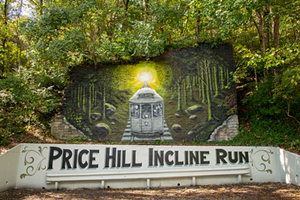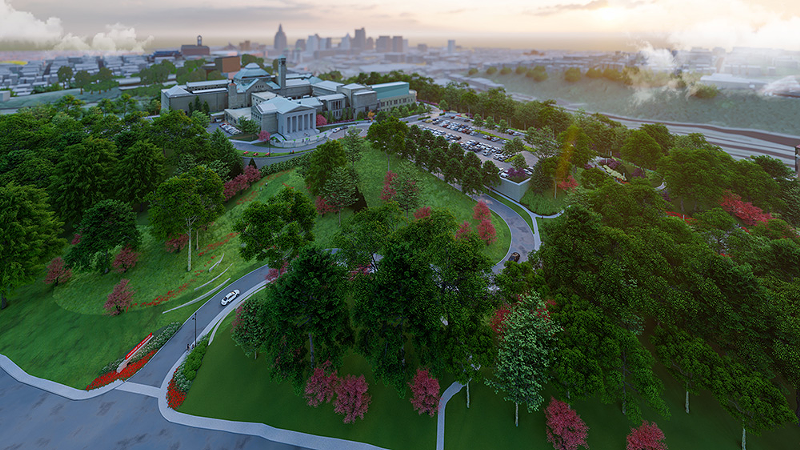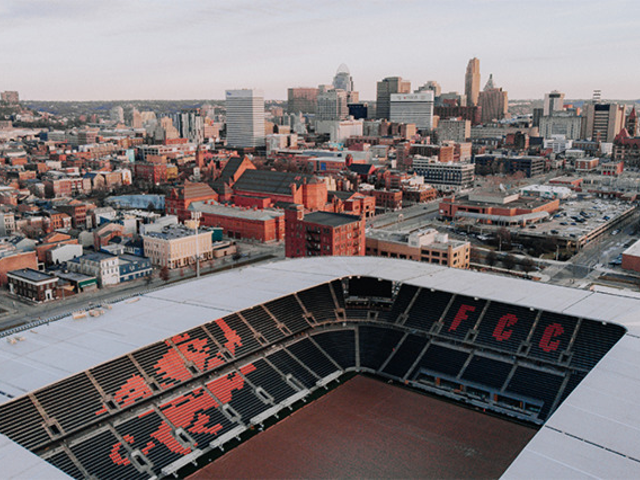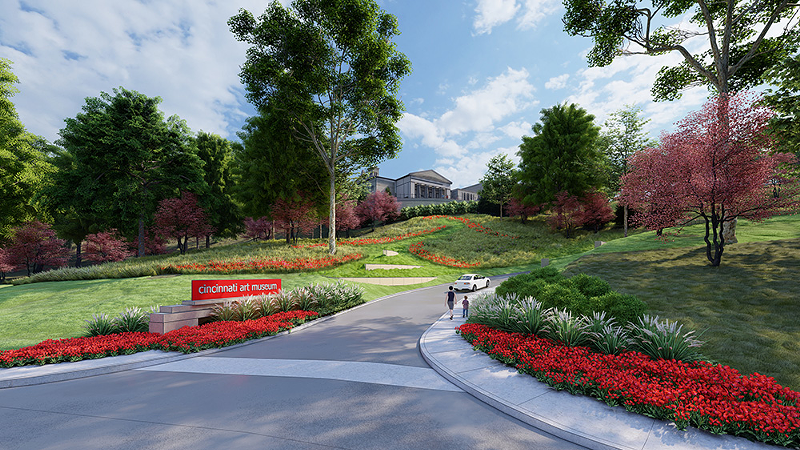
Within eight days of each other, there were two recent celebrations of growth in the arts that were superficially different yet had pronounced similarities.
The first, back on Sept. 29, was held outside the Cincinnati Art Museum’s main entrance and showcased the announcement of a $65 million fundraising campaign to create a sweeping “New View” of the institution. The museum’s prestigious Founders Society members — along with staff, docents and other supporters — gathered to sip from flutes of champagne, eat from the catered buffet of Cajun cuisine and applaud the speakers, including museum director Cameron Kitchin.
The signature project for the money (of which $55.3 million had been raised ahead of the event) is a scenic hillside entrance from Eden Park Drive up to the front of the museum. The roadway is already under construction, and Kitchin sees it as having a transformative effect on the museum’s outreach to the public.
The second event, on Oct. 7, was far smaller in crowd size, snack quantity and amount of money involved. Price Hill Will, a nonprofit community development corporation with a strong arts and culture component, celebrated the installation of outdoor artwork along a 550-foot hillside trail called Incline Run. The paved trail was once part of the roadway for scenic Maryland Avenue in East Price Hill but was closed off to motorists some 30 years ago. It has now been fixed up and reopened for pedestrians and cyclists, providing a user-friendly conduit for urban walkers.
The artwork includes a compelling new mural depicting a sort of dream-state trompe l’oeil version of the old Price Hill Incline, which used to travel up this very hillside but ceased operation in 1943. Lending it more of a magical-realism effect is the fact Benjamin Thomas had painted the scene right onto a remnant abutment of the old incline itself. The cost was $10,000, provided by Greater Cincinnati’s Devou Good Foundation. Just as Kitchin sees the art museum’s entrance drive as a game changer, Price Hill Will’s Samantha Conover sees the mural and all of Incline Run as having a transformative effect on Price Hill.
“We wanted to make it safer for residents, but it’s also now a feature other people can use as well,” she said at the event.
At $10,000 or $65 million, both organizations have growth and new activities on their minds as they try to turn rugged hillsides into assets. And they aren’t unique, either. Plenty of other local groups would like to tackle arts and culture projects.
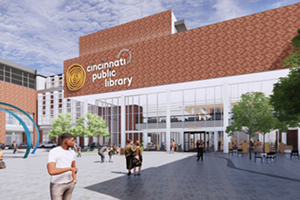
After almost two years of navigating the COVID-19 pandemic, local arts, cultural and educational organizations are cautiously hoping they can finally emerge from nightmare times with new ideas. Granted, that could change quickly should a new wave of the pandemic hit. But right now a number are at least considering — and, in some cases, already constructing — new buildings or redesigning existing ones. That list includes the Cincinnati Public Library’s main branch downtown, the Playhouse in the Park, Northern Kentucky’s Vent Haven ventriloquism museum, the Clifton Cultural Arts Center, Cincinnati Public Radio, the Cincinnati Type & Print Museum and others.
Not every expansion of activities is requiring money — at least not at first. Camp Washington’s Wave Pool, which since 2015 has created a sizable following for its vision of being a “contemporary art fulfillment center,” is expanding to Hamilton. And, initially at least, it’s virtually for free.
“It came about because Hamilton had a vacant firehouse in the East End it wanted to repurpose, and interested developers reached out to us,” Calcagno Cullen, Wave Pool’s executive director, tells CityBeat. “Right now, the property is being fixed up, so in about a year and a half we’ll be opening with art activities, installations and who knows what.”

“We’re going to start out with a very low budget,” she continues. “(The developers) got the property from Hamilton for virtually nothing if Wave Pool would have free rent on the first floor. So it’s kind of a nice deal for us, and they’re building out the space to suit our programmatic needs. We will have to have some kind of budget for artists and all the experiences we want to happen there, but it probably will be pretty scrappy to begin with.”
(According to Hamilton’s Journal-News, Primo Property Services LLC acquired the firehouse for $500, and will make the upper space short-rental.)
With so many projects out there, this story by necessity can’t be an exhaustive survey. It’s more of a sample. But it should be enough to impress readers with the breadth and variety of the forward-thinking attitude that’s out there. Yet it also should be stressed that much of this activity has pre-pandemic origins. Often, the beginning of COVID in March 2020 slowed things.
“What we’re seeing is a lot of work being done behind the scenes that’s finally here to talk about,” says Deborah Emont Scott, president and CEO of the Taft Museum of Art. “Cincinnatians should be very excited that all this is happening. It’s a great sign.”
The Taft’s $12.7 million Bicentennial Infrastructure Project, which is painstakingly rehabilitating the 200-year-old house that has been the museum’s home since 1932, was announced before the pandemic began. But Scott paused it when COVID arrived.
“We thought it was not appropriate for us to raise money for our project while there were so many people suffering,” she says. “COVID was such an unknown and such a horrendous thing that none of us felt good asking our donors to give to us instead of a foodbank.”
The Taft did already have enough money to redo a portion of the HVAC system, one of the overall project’s phases. Then work on a security system began earlier this year, followed by HGC Construction starting supervision of the major restoration phase this past August. The work is slated to be finished next March, with the Taft fully reopening in June after reinstalling the art collection and opening a big show called Jane Austen: Fashion & Sensibility. The Taft resumed its public fundraising campaign in October 2020 after it received a $500,000 matching grant from the federal government’s Save America’s Treasures program. (The Taft is a National Historic Landmark.)
Because the Cincinnati Art Museum is such a prominent presence in the community — a landmark institution in existence at its Eden Park location since 1886 — its dramatic plans for a new roadway deserve a closer look. It was an aesthetic decision as much as a utilitarian one. And, in a way, it’s a correction for a decision made back in 1947.
At that time, the museum’s main entrance was at its original building facing outward from the south side of the campus, toward Art Museum Drive and across from what is now Seasongood Pavilion. It was convenient to mass transit. As the museum grew, there were additions; the Schmidlapp Memorial Wing opened to the north in 1907 with its impressive exterior Doric columns.
As World War II ended and Americans embraced automobiles, the art museum’s board decided in 1947 to make Schmidlapp the main entrance and also build an adjacent parking lot. The traditional front entrance was closed off; eventually a new addition — the 1965 Adams-Emery Wing — with an accompanying subtle, lower-level entrance went up in front.
Kitchin, who arrived at Cincinnati Art Museum in 2014, saw this rear orientation as a disincentive for visitors, especially those who weren’t already regular museumgoers. Thus, the new front drive will serve as a grand approach to the main entrance.
“We know in arts-audience marketing that feeling welcome is of primary importance,” Kitchin says. “That sense of welcome sends every positive signal that all (people) belong at the art museum. Arriving at the front door is an act of hospitality.”
The art museum’s A New View initiative also encompasses the nearby Art Climb hillside stairway, which opened during the first months of the pandemic and quickly became an important urban safe space for socially distanced outdoor exercise. A New View also includes a growing outdoor sculpture collection; the newest piece, British-Nigerian artist Yinka Shonibare’s “Wind Sculpture IX,” debuted during the aforementioned Sept. 29 event.
“We realized the direction for enlarging the visitor experience and community interaction was looking outside the existing walls of the museum onto the hillsides, grounds and neighborhoods surrounding us,” Kitchin says.
There are some more familiar ways the museum will benefit from the money raised by A New View, such as gallery renovations and major traveling exhibitions. In fact, one has already been announced for 2023 — Pablo Picasso: Out of Bounds, which looks at the great artist’s landscapes. (In Charlotte, North Carolina, which will also have the Picasso show, the Mint Museum plans to ask the city and county governments for $500,000 to pay for the exhibit.)
West End’s Regal Theater at 1204 Linn St. is a site that also is considered a landmark for many Cincinnatians. After opening in 1914, it not only showed movies for its neighborhood audience, but also had concerts by some of the biggest names in Black music. But it’s been vacant since 1996. Now, it’s being eyed for reuse as the Robert O’Neal Multicultural Arts Center.
The Hamilton County Landbank, affiliated with the Port of Greater Cincinnati Development Authority, acquired and stabilized the property in 2013. Recently, arts professional Toilynn O’Neal Turner has been leading efforts to convert the Regal into a venue whose name would serve as a tribute to her late father, a painter who operated the Arts Consortium of Cincinnati, primarily a Black arts center, for several decades in the late 1960s. She sees the Regal as the right site, with the right history, to revive the spirit and legacy of her father’s place. And she’s trying to build citywide and neighborhood support for her cause.
“People definitely love the concept of saving the Regal, which is one of the of last iconic spaces of African American culture that’s left in our city that we can actually save,” she tells CityBeat.
She estimates a first phase of work on it would need $12 million; full renovation would be $22.9 million. She plans to begin a public fundraising campaign soon, and has also asked Cincinnati City Council for $4 million, Cincinnati Business Courier reported. Meanwhile, in an early show of corporate support, she received a $100,000 Duke Energy Urban Revitalization Grant in 2020 for architectural and engineering plans.
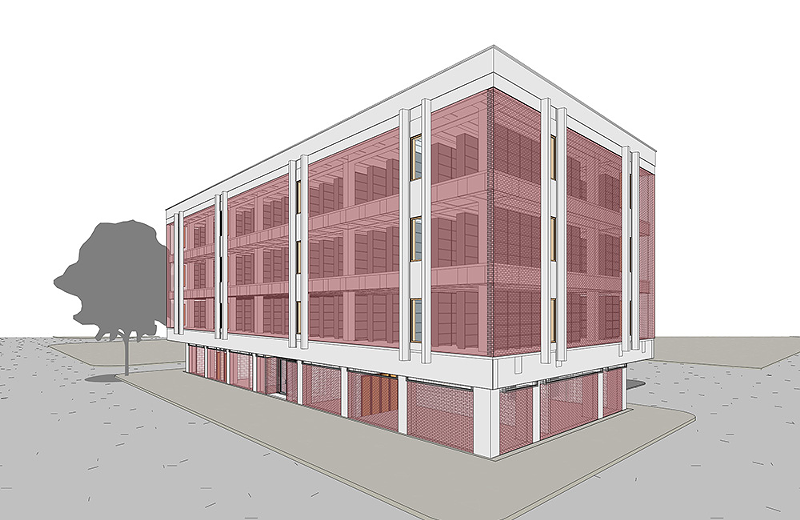
Downtown’s Lloyd Library & Museum is also a landmark Cincinnati institution, but maybe not so visible to the general public until recently. Now it has big ambitions for change. It was started by pharmacist brothers John Uri Lloyd, Nelson Ashley Lloyd and Curtis Gates Lloyd in the 1870s for their growing research collection of books about nature-based medicine and its history. The “museum” in the name originally referred to Curtis’ collections of plant and fungi specimens, which were given to other institutions after his death. In 1971, the library moved into a new and attractive modernist building at 917 Plum St. that, because of limited windows, seemed mysterious to passersby. The location holds the brothers’ vast collection of books, some of which date back to the 1400s.
In the past five years, the Lloyd has seen its attendance grow by 1,200 % as it has increased its exhibition calendar and initiated lectures and other public events about such timely issues as medicinal marijuana and food scarcity. It’s even hosted artists-in-residence. As a result, it has broadened its reach beyond visiting scholars using its archives for research, although there’s also been increased demand from them. So the Lloyd has just hired a Louisville design studio, DeLeon & Primmer Architecture Workshop, to prepare concepts for a major renovation that will reflect its expanding public uses while maintaining its effectiveness as a research library.
“The building we’re in is very inward looking and doesn’t communicate the fact that 80% of the people coming to Lloyd now are coming to view our exhibitions,” says its executive director, Patricia Van Skaik. “They’re coming to programs that make a connection between things in our collection and very important and critical contemporary issues of today. So we want a space that can accommodate our expanded role and look to our future.”
“And we also want an exterior that communicates the openness, so that people know it’s a community space open to public,” she says. “Right now when people drive by, they either don’t notice it or scratch their head and say, ‘What is that?’ ”
Another regional landmark preparing for higher visibility is Butler County’s Fortified Hill Earthworks, even though not many people currently are even aware of its existence. But that status is poised to change as it becomes a major part of the nearby Pyramid Hill Sculpture Park & Museum in Hamilton next year.
Fortified Hill is believed to have been created by the Hopewell Culture of American Indians some 2,000 years ago, according to the Ohio History Connection website. The earthworks form a kind of walled open-ended ring at the crest of a hill, which suggested a fort to the two men who surveyed it in 1847, according to Wikipedia. It is listed on the National Register of Historic Places.
It has long been located on private property, but in 2019 was put up for auction in four parcels when the landowner died. The Harry T. Wilks Family Foundation, which supports Pyramid Hill Sculpture Park (whose founder was Wilks), spent $1.5 million to acquire the parcels containing the earthwork in order to protect it and make it accessible to the public. Pyramid Hill is planning to begin its first guided tours on March 11 — which it celebrates as Founder’s Day.
But getting people to see and understand the earthwork, which may have been used for ceremonies, has physical as well as educational challenges.
“We want to be mindful there are parts you’d be standing right on before you’d realize this is it,” says Bryan W. Knicely, Pyramid Hill’s executive director. “The mound itself over the years has been covered with trees and honeysuckle, and we have to be careful in how we clear that land. We hope to just show them this is where we’re beginning, and in two years we’ll be at (a further) point, and three years another.”
To that end, the museum is working with a committee and representatives of Greater Cincinnati American Indian Coalition.
“For us, it’s about teaching people the history of this region and the peoples here before us, making sure we preserve something they created and talk about it accurately,” Knicely says.
Satisfyingly, two smaller Cincinnati organizations have not only survived the pandemic, but indeed have also made progress on their ambitious plans.
One is the Over-the-Rhine Museum, whose website explains its mission as one to acquire a historic tenement and “use the stories of the building’s (past) residents to explore the larger history of America.” Not long before the pandemic started, it acquired such a vacant building at 3 W. McMicken Ave./12 Findlay St. Now, it has a $75,000 fundraising campaign underway to begin rehab of a portion of it so people can visit.
“The idea is to begin with the storefront that is facing the public (on the McMicken side),” says Anne Delano Steinert, the museum’s founder. “Right now, we basically have a mothballed historic building, which doesn’t help the neighborhood look welcoming or promote vitality on our block. Once we have the storefront all gussied up, we’ll create six to seven panels that will face outward from the storefront windows and explore a variety of the residents who have lived in the building over time. This will express the idea that while Over-the-Rhine has a foundational and important German heritage, there are also many other people who have lived there over time. The museum’s mission is to tell all those stories.”
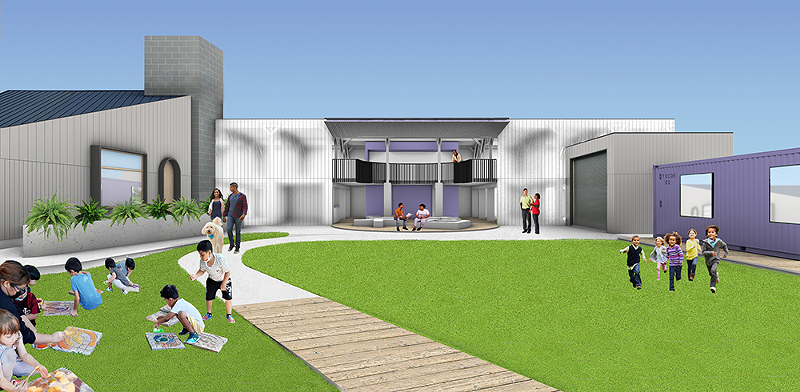
Finally, you have to admire an arts center that can not only emerge from the tough past years with lots of big news, but also with a touching sense of humor. That’s the case with Northside’s PAR-Projects, which has slowly been working to turn its site at 1662 Hoffner St. into “diverse communities of people who believe in the arts,” according to its website. It recently made three big, long-awaited announcements at once:
First, three years of working with city officials, it has finally received permission from the Cincinnati Zoning Commission to move forward with plans for an outdoor movie theater, concert stage and installation art gallery.
After purchasing an adjacent building to gain a 15,000 square-foot multi-use space, it quietly launched a $600,000 capital campaign that so far has netted over $150,000.
It also has received a $150,000 challenge grant from the Carol Ann and Ralph V. Haile, Jr. Foundation that kicks in when PAR-Projects reaches $300,000 from other sources. Now it is about to announce a $100,000 community campaign via the ioby fundraising platform.
PAR-Projects was going to announce all this to those who attended a Sunday afternoon social event at its property on Oct. 10. But the news fell through the cracks at the party, so Jonathan Sears, the organization’s executive director, wittily apologized in a follow-up email that nicely encapsulates how we all feel about trying to reenter the world we took for granted before the pandemic arrived. Here it is:
“Hi There!
Before our last Beer Burger Brunch, we promised to make a few major announcements at the event. And quite frankly, after getting lost in the newness of our first food event since the COVID shutdown (who hid the spatulas?) that…slipped our minds.
So again, ‘Thank you!’ to our patient friends out there who helped us shake off the cobwebs and get back on our feet a couple short weeks ago. Sorry to keep you waiting!”
It, along with everything else happening in the arts, will be worth the wait.
Sign up for our weekly newsletters to get the latest on the news, things to do and places to eat delivered right to your inbox.
Follow us on Facebook, Twitter and Instagram.

